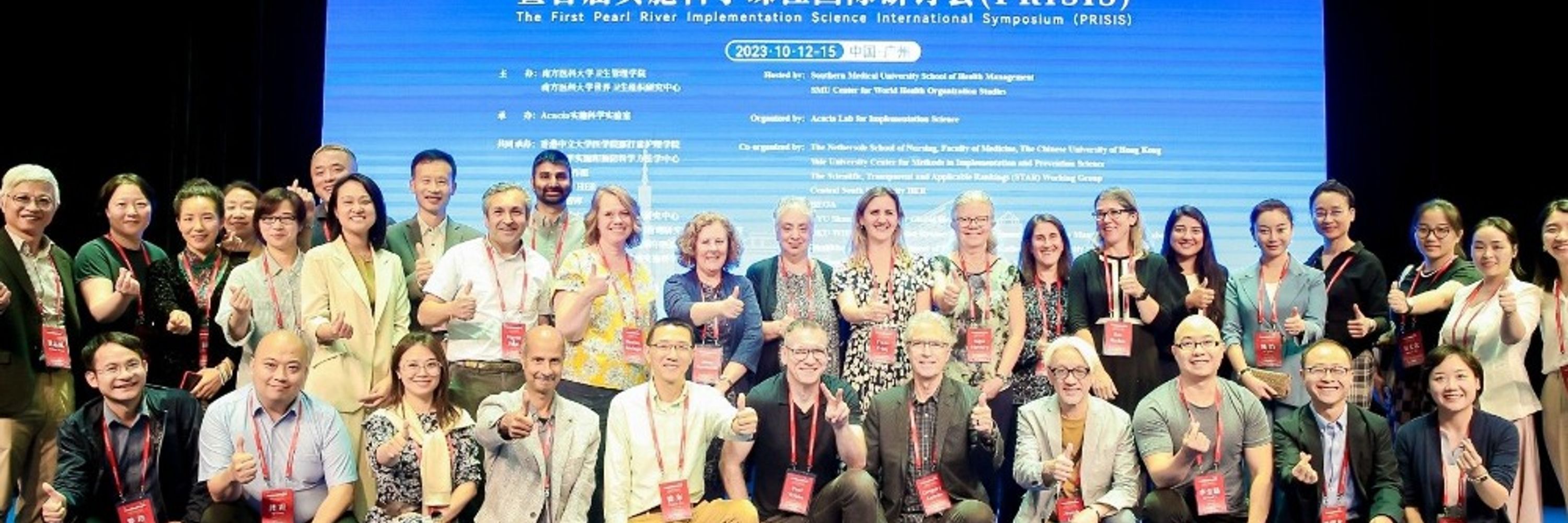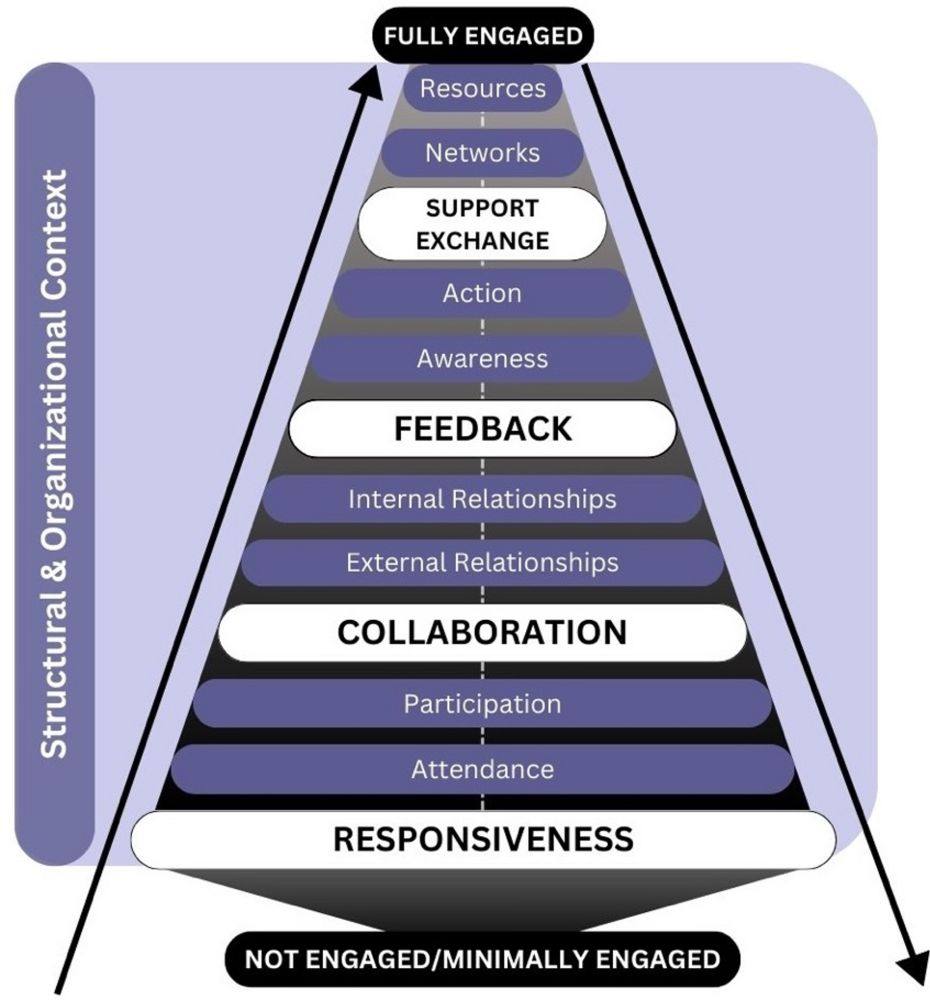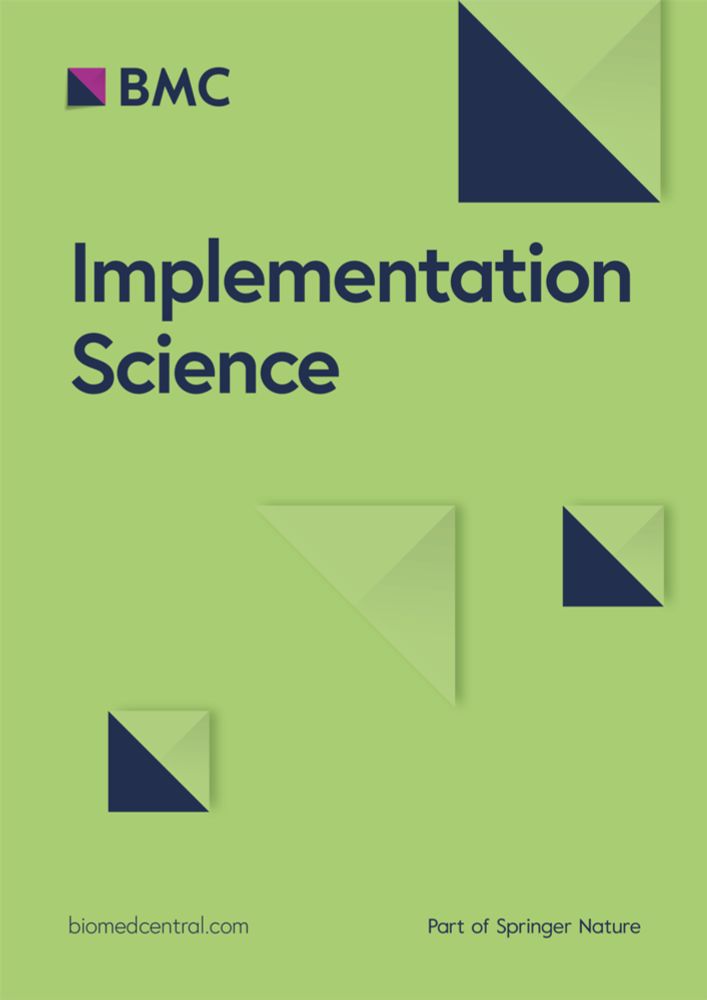
Dr. Gregory Aarons
@drgregaarons.bsky.social
Implementation research, runner, editor @Implementation Science, funded by NCI, NIDA, NIMH, FIC, working to improve domestic & global health through implementation science, https://episframework.com/, https://www.implementationleadership.com/
We published the participatory community-engaged implementation strategy "Dynamic Adaptation Process" (DAP) in 2012 - here is a 2025 demonstration of the DAP to reduce factors related to adolescent #suicide in schools doi.org/10.3389/frhs...

Frontiers | Leveraging the dynamic adaptation process to address LGBTQ+ health equity in New Mexico high schools
BackgroundReducing adolescent suicide in the United States is a public health priority, and lesbian, gay, bisexual, transgender, and queer (LGBTQ+) youth are...
doi.org
October 13, 2025 at 10:47 PM
We published the participatory community-engaged implementation strategy "Dynamic Adaptation Process" (DAP) in 2012 - here is a 2025 demonstration of the DAP to reduce factors related to adolescent #suicide in schools doi.org/10.3389/frhs...
Study led by Irene Su, M.D. - EPIS framework illustrates when a legislative health policy is passed, it winds its way through a maze of insurance regulation, health insurer benefit design, and how health care organizations and patients navigate these structures and processes. doi.org/10.1186/s130...

Implementation of state health insurance benefit mandates for cancer-related fertility preservation: following policy through a complex system - Implementation Science
Background A myriad of federal, state, and organizational policies are designed to improve access to evidence-based healthcare, but the impact of these policies likely varies due to contextual determinants of, reinterpretations of, and poor compliance with policy requirements throughout implementation. Strategies enhancing implementation and compliance with policy intent can improve population health. Critically assessing the multi-level environments where health policies and their related health services are implemented is essential to designing effective policy-level implementation strategies. California passed a 2019 health insurance benefit mandate requiring coverage of fertility preservation services for individuals at risk of infertility due to medical treatments, in order to improve access to services that are otherwise cost prohibitive. Our objective was to document and understand the multi-level environment, relationships, and activities involved in using state benefit mandates to facilitate patient access to fertility preservation services. Methods We conducted a mixed-methods study and used the policy-optimized exploration, preparation, implementation, and sustainment (EPIS) framework to analyze the implementation of California’s fertility preservation benefit mandate (SB 600) at and between the state insurance regulator, insurer, and clinic levels. Results Seventeen publicly available fertility preservation benefit mandate-relevant documents were reviewed. Interviews were conducted with four insurers; 25 financial, administrative, and provider participants from 16 oncology and fertility clinics; three fertility pharmaceutical representatives; and two patient advocates. The mandate and insurance regulator guidance represented two “Big P” (system level) policies that gave rise to a host of “little p” (organizational) policies by and between the regulator, insurers, clinics, and patients. Many little p policies were bridging factors to support implementation across levels and fertility preservation service access. Characterizing the mandate’s functions (i.e., policy goals) and forms (i.e., ways that policies were enacted) led to identification of (1) intended and unintended implementation, service, and patient outcomes, (2) implementation processes by level and EPIS phase, (3) actor-delineated key processes and heterogeneity among them, and (4) inner and outer context determinants that drove adaptations. Conclusions Following the midstream and downstream implementation of a state health insurance benefit mandate, data generated will enable development of policy-level implementation strategies, evaluation of determinants and important outcomes of effective implementation, and design of future mandates to improve fit and fidelity.
doi.org
October 10, 2025 at 4:18 AM
Study led by Irene Su, M.D. - EPIS framework illustrates when a legislative health policy is passed, it winds its way through a maze of insurance regulation, health insurer benefit design, and how health care organizations and patients navigate these structures and processes. doi.org/10.1186/s130...
Adverse childhood experiences (ACES) are linked to lifespan physical & mental health problems. This study led by Monica Perez-Jolles improved ACES screening outcomes using a multi-faceted implementation strategy. @ucsd-disc.bsky.social @accordsresearch.bsky.social link.springer.com/article/10.1...

Testing a multi-faceted strategy to support the implementation of ACEs screenings in primary care: results of a stepped-wedge pilot trial - Implementation Science Communications
Background Adverse Childhood Experiences (ACEs) screenings are increasingly being used in primary care clinics to identify toxic stress and potential trauma in children. ACEs are negative life events (e.g., violence exposure) occurring before age 18, that can increase health risks when unaddressed. However, we lack evidence on the impact of ACEs screenings and how they can be feasibly implemented in community-based clinics. We partnered with federally qualified health clinics to test the impact of a multifaceted implementation strategy on ACEs screening reach and mental health referrals for children ages 0–5. Methods We conducted a Hybrid Type 2 pilot trial using a stepped-wedge design (2021–2024). Reach data was measured as the proportion of eligible children screened for ACEs, with data collected from Electronic Health Records. We also assessed the percentage of mental health service referrals among all eligible children. Study clinics (n = 3) switched from no ACEs screenings (control) to implementing ACEs screenings supported by the multi-faceted ACE implementation strategy (intervention). The tested strategy comprised personnel training (e.g., trauma-informed care), integrated technology, team-based screening workflows, and ongoing care team implementation support. Additional clinics (n = 2) implemented ACEs screenings as usual without the strategy and served as additional comparison sites for exploratory analyses. Log-binomial and robust Poisson regression models examined differences in screening reach and referrals and were adjusted for site and patient race. Results Screening reach rates increased in the intervention period, from 0.0% of patients screened during control to 11.2% screened during intervention. Mental health service referrals increased from 0.4% at control to 7.2% during the intervention, resulting in a risk difference (95% confidence interval) of 6.9% (6.0%, 7.7%). For both the reach and referral outcomes, risk differences were significantly greater for 18-to-60-month-old patients than for patients under 18-months-old. Discussion Healthcare policy efforts promoting ACEs screenings in primary care are commendable. We found that a multi-faceted implementation strategy informed by partners and designed to support ACEs screenings in community-based clinics was feasible. However, its impact was attenuated by policy requirements, clinics’ capacity to add ACEs screenings to strained workflows, and multiple impactful outer-context events related and unrelated to the COVID-19 pandemic. Trial registration Trial # NCT04916587 registered at clinicaltrials.gov on June 4, 2021, https://clinicaltrials.gov/study/NCT04916587
link.springer.com
October 8, 2025 at 12:07 AM
Adverse childhood experiences (ACES) are linked to lifespan physical & mental health problems. This study led by Monica Perez-Jolles improved ACES screening outcomes using a multi-faceted implementation strategy. @ucsd-disc.bsky.social @accordsresearch.bsky.social link.springer.com/article/10.1...
Reposted by Dr. Gregory Aarons
The University of Glasgow groundspeople are going to be quite annoyed when they come in to work tomorrow...
October 1, 2025 at 5:59 PM
The University of Glasgow groundspeople are going to be quite annoyed when they come in to work tomorrow...
New article led by Sarah Jones with an approach to site engagement in multisite #implementation research healthandjusticejournal.biomedcentral.com/articles/10....

Site engagement in implementation research: Introducing SEAMLIS as a conceptual and measurement framework - Health & Justice
Background Multisite implementation research in justice and health settings often does not systematically assess differential degrees of project involvement among participating sites, despite its impl...
healthandjusticejournal.biomedcentral.com
July 14, 2025 at 4:39 PM
New article led by Sarah Jones with an approach to site engagement in multisite #implementation research healthandjusticejournal.biomedcentral.com/articles/10....
Reposted by Dr. Gregory Aarons
Reposted by Dr. Gregory Aarons
📢 Join us for the June EPIS Office Hours! We’re excited to welcome Dr. Marisa Sklar as our guest host this month! Please note: June’s office hours will be held at only one time point (8-9 am PT) drop by to ask questions and connect with an EPIS expert. #EPISFramework

June 5, 2025 at 9:59 PM
📢 Join us for the June EPIS Office Hours! We’re excited to welcome Dr. Marisa Sklar as our guest host this month! Please note: June’s office hours will be held at only one time point (8-9 am PT) drop by to ask questions and connect with an EPIS expert. #EPISFramework
New study results on the Dynamic Adaptation Process #implementation strategy use for #EBPs for #LGBTQ+ youth and including #nurses in #schools
www.frontiersin.org/journals/hea...
www.frontiersin.org/journals/hea...

Frontiers | Leveraging the dynamic adaptation process to address LGBTQ+ health equity in New Mexico high schools
BackgroundReducing adolescent suicide in the United States is a public health priority, and lesbian, gay, bisexual, transgender, and queer (LGBTQ+) youth are...
www.frontiersin.org
June 5, 2025 at 5:29 PM
New study results on the Dynamic Adaptation Process #implementation strategy use for #EBPs for #LGBTQ+ youth and including #nurses in #schools
www.frontiersin.org/journals/hea...
www.frontiersin.org/journals/hea...
Reposted by Dr. Gregory Aarons
It’s @arc-southlondon.bsky.social Implementation Science Masterclass time @kingscollegelondon.bsky.social Big thanks to our colleagues joining from all over the world to share their expertise including @drgregaarons.bsky.social @grahammoore.bsky.social and many more 🙏

June 2, 2025 at 4:51 PM
It’s @arc-southlondon.bsky.social Implementation Science Masterclass time @kingscollegelondon.bsky.social Big thanks to our colleagues joining from all over the world to share their expertise including @drgregaarons.bsky.social @grahammoore.bsky.social and many more 🙏
I am so looking forward to this fun event with creative ways to communicate about implementation science!
One of my highlights next week is The Science Slam at the 2025 European Implementation Event in Newcastle with a great lineup of slammers, including @drgregaarons.bsky.social - you can register for the #EIE2025 until tomorrow! #ImpSci

June 1, 2025 at 9:34 AM
I am so looking forward to this fun event with creative ways to communicate about implementation science!
New paper led by @drcathycorbin.bsky.social the School Implementation Citizenship Behavior Scale. Strong #implementation #citizenship means that employees help others, keep informed, take initiative, & advocate for #EBP implementation. implementationsciencecomms.biomedcentral.com/articles/10....

“Going above and beyond” for implementation in the education sector: extension and validation of the School Implementation Citizenship Behavior Scale (SICBS) - Implementation Science Communications
Background Employee behaviors that strategically support implementation (i.e., implementation citizenship behavior [ICB]) theoretically promote the adoption and high-fidelity use of evidence-based pra...
implementationsciencecomms.biomedcentral.com
May 26, 2025 at 8:23 PM
New paper led by @drcathycorbin.bsky.social the School Implementation Citizenship Behavior Scale. Strong #implementation #citizenship means that employees help others, keep informed, take initiative, & advocate for #EBP implementation. implementationsciencecomms.biomedcentral.com/articles/10....
Excited to share our new article led by Kera Swanson on using the Translational Science Benefits Model (TSBM) to demonstrate the real-world impact of #translational and #implementation #science @ucsd-disc.bsky.social @implementeic.bsky.social
www.frontiersin.org/journals/hea...
www.frontiersin.org/journals/hea...

Frontiers | An iterative approach to evaluating impact of CTSA projects using the translational science benefits model
IntroductionDemonstrating the relevance and impact of translational research across diverse settings is crucial making the research-to-practice pipeline more...
www.frontiersin.org
May 23, 2025 at 8:06 PM
Excited to share our new article led by Kera Swanson on using the Translational Science Benefits Model (TSBM) to demonstrate the real-world impact of #translational and #implementation #science @ucsd-disc.bsky.social @implementeic.bsky.social
www.frontiersin.org/journals/hea...
www.frontiersin.org/journals/hea...
Reposted by Dr. Gregory Aarons
Improving #implementation is key to overcoming #policy failure, write CEI experts Jane Lewis & Dr Robyn Mildon in a commentary for @schoolforgovt.bsky.social. #impsci #evidence #research #practice #scaling
"...we don't see the services, interventions and approaches that are of proven effectiveness being taken up, embedded and sustained at scale. This is implementation failure...It's there in every policy area, and it's profound."
Jane Lewis of @cei-global.bsky.social writes for our comment series
Jane Lewis of @cei-global.bsky.social writes for our comment series

Reducing policy failure means addressing policy implementation
Services, interventions and approaches that are of proven effectiveness are not being taken up at scale
www.kcl.ac.uk
May 12, 2025 at 7:24 AM
Improving #implementation is key to overcoming #policy failure, write CEI experts Jane Lewis & Dr Robyn Mildon in a commentary for @schoolforgovt.bsky.social. #impsci #evidence #research #practice #scaling
please share with your networks@ucsd-disc.bsky.social @implementsci.bsky.social @implementeic.bsky.social @impact-swiss.bsky.social @washu-dandi.bsky.social
Please see our editorial led by @rsbeidas.bsky.social on the impact of US federal grant terminations on the field of implementation science in the US and globally. imphttps://implementationscience.biomedcentral.com/articles/10.1186/s13012-025-01434-7

Implementation science grant terminations in the United States - Implementation Science
implementationscience.biomedcentral.com
May 8, 2025 at 10:00 PM
please share with your networks@ucsd-disc.bsky.social @implementsci.bsky.social @implementeic.bsky.social @impact-swiss.bsky.social @washu-dandi.bsky.social
Please see our editorial led by @rsbeidas.bsky.social on the impact of US federal grant terminations on the field of implementation science in the US and globally. imphttps://implementationscience.biomedcentral.com/articles/10.1186/s13012-025-01434-7

Implementation science grant terminations in the United States - Implementation Science
implementationscience.biomedcentral.com
May 8, 2025 at 9:26 PM
Please see our editorial led by @rsbeidas.bsky.social on the impact of US federal grant terminations on the field of implementation science in the US and globally. imphttps://implementationscience.biomedcentral.com/articles/10.1186/s13012-025-01434-7
Potential impact for global health research. www.nature.com/articles/d41...

Exclusive: NIH to suspend funds for research abroad as it overhauls policy
Move by US biomedical agency threatens thousands of projects on infectious diseases, cancer and more.
www.nature.com
May 1, 2025 at 3:34 AM
Potential impact for global health research. www.nature.com/articles/d41...
Hey! We are not at war!!

March 29, 2025 at 12:14 AM
Hey! We are not at war!!
Reposted by Dr. Gregory Aarons
BREAKING UPDATE:
Wisconsin Attorney General Josh Kaul is suing Elon Musk to block his $1 million bribes to voters.
www.pbs.org/newshour/pol...
Wisconsin Attorney General Josh Kaul is suing Elon Musk to block his $1 million bribes to voters.
www.pbs.org/newshour/pol...
March 29, 2025 at 12:04 AM
BREAKING UPDATE:
Wisconsin Attorney General Josh Kaul is suing Elon Musk to block his $1 million bribes to voters.
www.pbs.org/newshour/pol...
Wisconsin Attorney General Josh Kaul is suing Elon Musk to block his $1 million bribes to voters.
www.pbs.org/newshour/pol...
Reposted by Dr. Gregory Aarons
Trump just withdrew the bad CDC nominee after public blowback about the measles vaccine.
Scientists, we can achieve the same with the bad NIH nominee. Public pressure can force out Bhattacharya.
Your voices are needed now. Please take action. 🧪
Scientists, we can achieve the same with the bad NIH nominee. Public pressure can force out Bhattacharya.
Your voices are needed now. Please take action. 🧪

White House withdraws Trump's pick Dave Weldon as CDC director pick
The White House is withdrawing President Donald Trump's nomination of Republican former congressman and vaccine critic Dave Weldon to serve as director of the U.S. Centers for Disease Control and Prevention, a source briefed on the matter said on Thursday.
www.reuters.com
March 13, 2025 at 1:38 PM
Trump just withdrew the bad CDC nominee after public blowback about the measles vaccine.
Scientists, we can achieve the same with the bad NIH nominee. Public pressure can force out Bhattacharya.
Your voices are needed now. Please take action. 🧪
Scientists, we can achieve the same with the bad NIH nominee. Public pressure can force out Bhattacharya.
Your voices are needed now. Please take action. 🧪
Reposted by Dr. Gregory Aarons
@mcuban.bsky.social this is a long shot but my account is small & the losses to science are too great to not ask for favors. Please consider getting the word out about AHRQ & NIH funding cuts. We are losing a generation of scientists & American innovation. Thanks! 🤞🙏
March 21, 2025 at 10:46 PM
@mcuban.bsky.social this is a long shot but my account is small & the losses to science are too great to not ask for favors. Please consider getting the word out about AHRQ & NIH funding cuts. We are losing a generation of scientists & American innovation. Thanks! 🤞🙏
Reposted by Dr. Gregory Aarons
🙏 Shameless ask: It’s my birthday. Scientists, please call your Congress peeps & tell them why AHRQ & NIH are critical to curing cancer, treating & preventing substance use, ensuring healthcare access in rural America, the list goes on. Without real #AHRQ & #NIH funding we will be a sicker country.
🚨 AHRQ is feared to be the next target for mass layoffs by the Trump administration. The agency conducts essential research on rural health, nutrition, health care quality and costs, and lawmakers are taking the threat to its staffing seriously. Read more in STAT News:

HHS agency responsible for health care quality research threatened with mass layoffs
AHRQ, a small government agency responsible for health care quality research, is feared to be the latest target for mass layoffs by the Trump administration.
buff.ly
March 21, 2025 at 10:22 PM
Reposted by Dr. Gregory Aarons
From 2010 to 2016 (latest data I have ), NIH research contributed to EVERY drug approved by the FDA

March 22, 2025 at 10:44 AM
From 2010 to 2016 (latest data I have ), NIH research contributed to EVERY drug approved by the FDA
Reposted by Dr. Gregory Aarons
Sources inside NIH say DOGE is at one of their buildings right now.
If you have additional info, i’m marisakabas.04 on Signal.
If you have additional info, i’m marisakabas.04 on Signal.
March 19, 2025 at 4:21 PM
Sources inside NIH say DOGE is at one of their buildings right now.
If you have additional info, i’m marisakabas.04 on Signal.
If you have additional info, i’m marisakabas.04 on Signal.




